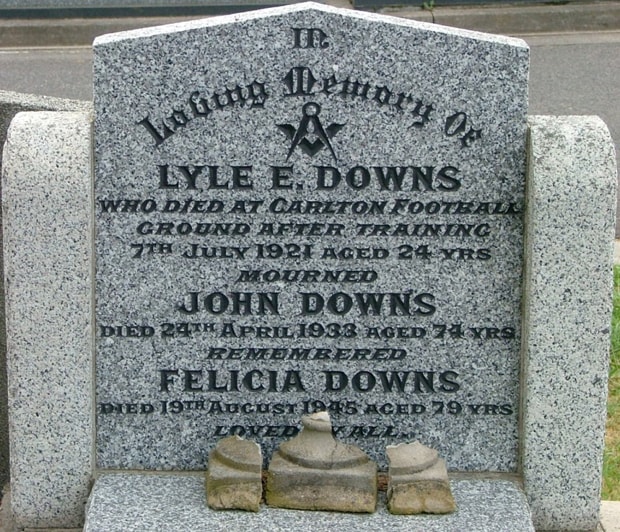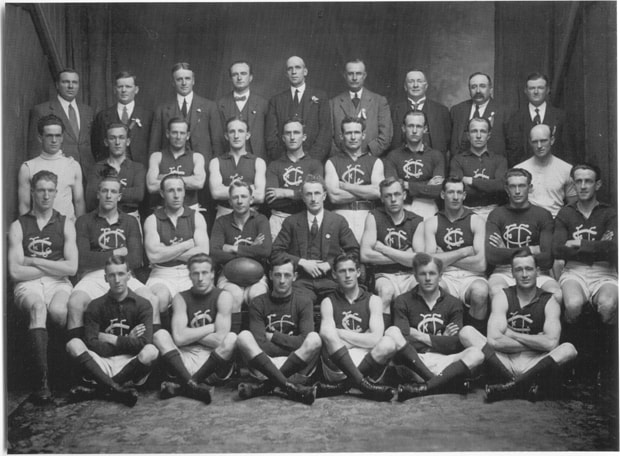The Australian cricketers have again donned their creams and made for centre wicket, taking with them the deeply personal memories of a recently lost mate.
They go out with heavy hearts, with the tragic and untimely passing of Phil Hughes still raw – as it surely was for the Carlton players who bore witness to the harrowing final moments of one of their own some 93 years ago.
It happened at Princes Park on the night of Thursday, July 7, 1921, when “Horrie” Clover led his men from the track after an uneventful training session on the old ground.
The players had just retired to the confines of the dressing room when resident rover Lyle Downs inexplicably collapsed by his locker.
Dr Strachan, the club doctor, was there to lend urgent assistance. But try as he might, there was little he could do for the 47-game rover. For Downs drew his last breath in front of all of them . . . and he died with his boots on.

Lyle Downs is buried at Melbourne General Cemetery. (Photo: Carlton Football Club)
Recruited to Carlton from the neighboring Clifton Hill Juniors Football Club, Lyle Downs was 19 days shy of his 25th birthday and not yet at the peak of his playing powers when his young heart gave out.
Though he had known of his heart defect for more than three years, Downs resolved to push on with the game he loved, with obviously catastrophic consequences.
Downs was laid to rest at Melbourne General Cemetery, just a few hefty placekicks from the old Carlton ground. His passing was acknowledged in the club’s 1921 Annual Report to Members as follows;
DEATH OF LYLE DOWNS
It is with extreme regret that we have to record the sudden and tragic death of our wonderful little “rover” and “forward” (Lyle Downs), who passed away in the training room after indulging in light practice on July 7. He was one of the gamest and most brilliant players who ever kicked a football, and he had given fine service to your Club, both on the field and as a member of the Committee. He was extremely popular, and his untimely death cast a gloom over the whole Club. On your behalf, deepest sympathy was conveyed to his sorrowing parents. The esteem in which he was held by all classes of sportsmen was shown by the thousands who attended his funeral. His death was a distinct loss to the Club and a severe blow to all who knew him.
It’s doubtful that few of the 31 senior players who turned out for Carlton in that ill-fated season of 1921 truly came to terms with the tragic and untimely loss of their mate Lyle - least of all Horace Ray (“Horrie”) Clover, whose career path was reputedly mapped out by Downs the day he saw Clover’s sublime skills on show in a friendly game of kick-to-kick.
Clover, perhaps Maryborough’s greatest sporting prodigy next to John Nicholls, was often thought of as the father of the drop punt. According to the late Newton Chandler, Clover once caught glimpse of a footballer executing the kick at Carisbrook and later refined the method.
Clover was declared Champion of the Colony in 1921 – an award originally bestowed for all round sporting excellence. Together with Albert Boromeo, Greenhill and Rupe Hiskins, Clover also represented Victoria against Western Australia in the carnival.

The 1921 Carlton team. Horrie Clover is seated in the second row, second from right. (Photo: Carlton Football Club)
The Herald also conducted a “Champion Footballer” competition “and it gave extreme satisfaction to your club to learn that our champion, Mr. Horace Clover, had easily won the medal for being the champion “forward” of Victoria. There is no doubt whatever that he did occupy that position, and we heartily congratulate him”.
A fortnight after Downs’s death, against St Kilda in Round 7, Horrie booted an incredible 13 goals from centre half-forward – a club record that still stands.
Clover’s glorious on-field feats obviously impacted on the Carlton players around him. Under captain GV Green, they gave it their all for Downs, posting 16 wins, three losses and two draws from 21 starts.
Though the Carltonites followed up with victory over Collingwood in the first-semi, they twice lost to eventual premier Richmond in what was regarded as “two of the most strenuous and exciting games ever played on the Melbourne Cricket Ground”.
To further quote the Annual Report;
“The final, played on October 8, will always be remembered by the thousands present, as the ground, after a tremendous fall of hail at half-time, presented a wonderful spectacle, unprecedented in the annals of Victorian football.
“Victory in either final against Richmond would have afforded Carlton victory. Regrettably they lost the first by eight points, the second by just four. These were truly the Shoodabeen Champions.”
. . . and to a man they gave their all for poor Lyle.



